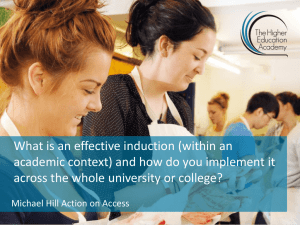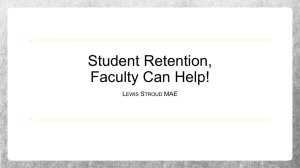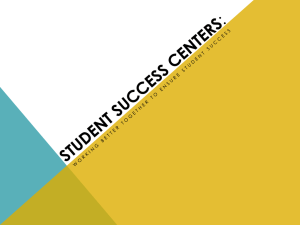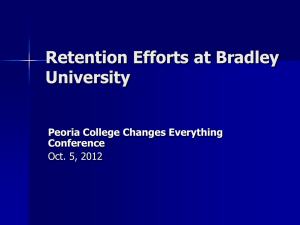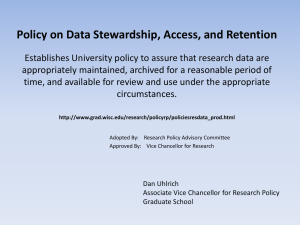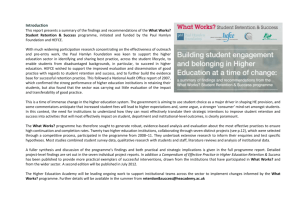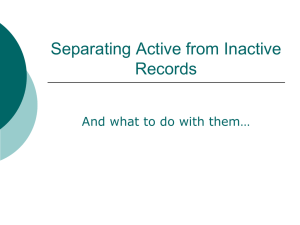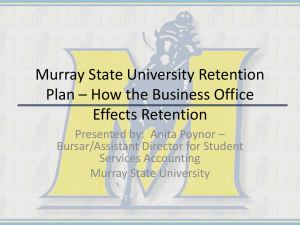What works? Facilitating an effective transition into higher education
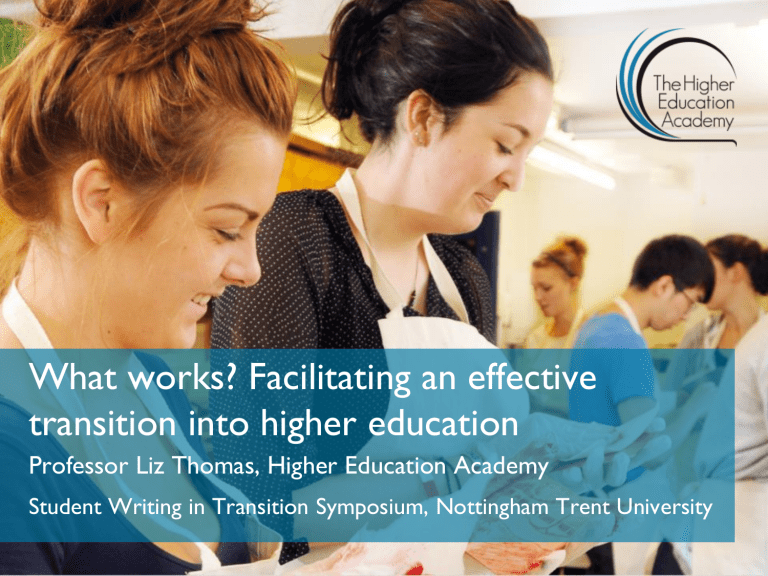
What works? Facilitating an effective transition into higher education
Professor Liz Thomas, Higher Education Academy
Student Writing in Transition Symposium, Nottingham Trent University
Overview
• Retention and non-completion in England.
• What works? Student retention and success programme
• What works? model: Improving student engagement, belonging, retention and success
• Characteristics of effective interventions and approaches
• Effective transition: pre-entry, induction and learning and teaching in the first semester/year
• Small group activity: Student stories
• Examples of effective practice from What works?
• Small group activity: Sharing effective practice
• Reflective checklist
• Implementing change
2
Defining retention the English way
“The first is the ‘completion rate’ – the proportion of starters in a year who continue their studies until they obtain their qualification, with no more than one consecutive year out of higher education. As higher education courses take years to complete, an expected completion rate is calculated by the Higher Education
Statistics Agency… A more immediate measure of retention is the proportion of an institution’s intake which is enrolled in higher education in the year following their first entry to higher education. This is the ‘continuation rate’.” (NAO, 2007, p5).
3
Non-continuation, completion and thinking about leaving
• The average non-continuation rate was 8.4% for entrants to
English higher education institutions in 2009-10;
• Non-continuation rates varied between English institutions between 1.2% and 21.4% in 2009-10;
• The average completion rate for students entering institutions in England in 2009-10 was projected to be 78.4%; and
• Completion rates were projected to vary between institutions between 53.8% and 97.2% in 2009-10.
• Between 33% (1/3) and 42% (2/5) of students think about withdrawing from HE.
What works? Student retention and success programme
• NAO (2007) and PAC (2008): Lack of progress and lack of evidence about what works.
• £1 million (Paul Hamlyn Foundation and HEFCE) to support 7 projects involving 22 HEIs to identify, evaluate and disseminate effective practice.
• The primary purpose of the programme is to generate robust, evidence-based analysis and evaluation about the most effective practices to ensure high continuation and completion rates.
5
From theory to practice
‘Most institutions have not yet been able to translate what we know about student retention into forms of action that have led to substantial gains in student persistence and graduation.’
(Professor Vincent Tinto HEA retention conference 2006)
6
Seven evaluation projects
1) A comparative evaluation of the roles of student adviser and personal tutor in relation to undergraduate student retention, Anglia Ruskin University
2) Pathways to Success through peer mentoring, Aston
University
3) ‘Belonging’ & ‘intimacy’ factors in the retention of students, University of Leicester
4) Dispositions to Stay: The Support and Evaluation of
Retention Strategies Using the Effective Lifelong Learning
Inventory (ELLI), Northumbria University
7
Seven evaluation projects
5) Project 5: HERE! Higher education retention & engagement, Nottingham Trent University
6) Comparing and evaluating the impacts on student retention of different approaches to supporting students through study advice and personal development,
University of Reading
7) Good Practice in Student Retention: an Examination of the effects of student integration on non-completion,
University of Sunderland
Selected through a competitive tender process.
8
Key messages
• The key message from these 7 projects is the centrality of students having a strong
sense of belonging in HE; this is most effectively nurtured in the academic
sphere.
• This puts high quality student-centred
learning and teaching at the heart of effective student retention and success.
9
Key messages
Student belonging is an outcome of:
• Supportive peer relations.
• Meaningful interaction between staff
and students.
• Developing knowledge, confidence and
identity as successful HE learners.
• An HE experience which is relevant to
interests and future goals.
10
Key findings
• Between 1/3 and 2/5 of students think about withdrawing from HE.
• Academic issues, feelings of isolation and/or not fitting in and concern about achieving future aspirations are the primary reason why students think about leaving.
• Early engagement in the academic sphere (pre-entry, induction and first semester) can develop peer networks and friendships, create links with academic members of staff, provide key information, inform realistic expectations, improve academic skills, develop student confidence and nurture a sense of belonging.
11
Key findings
• Relationships between staff and students and peers promote and enable student engagement and success in
HE. These should be nurtured pre-entry, in the classroom and in the delivery of professional services.
• Some programmes have better rates of retention than would be predicted on the basis of entry grades; and some specific interventions have been shown to improve retention rates by around 10 percentage points.
• Particularly effective interventions are situated in the academic sphere and have an overt academic purpose, while also developing peer and staff/student relations.
12
Staff capacity building
Institutional management and co-ordination
Student capacity building
Academic
Social Service
E a r l y e n g a g e m e n t e x t e n d s i n t o H E a n d b e y o n d
Implementation: Characteristics of effective interventions and approaches
Mainstream
Monitored
Proactive
Belonging
Collaborative
Well timed & appropriate media
Relevant
14
What works process
Implementation
(activity)
Engagement
(level 1 outcomes)
Belonging
(level 2 outcome)
Retention and success
(impact)
15
Student voices
“I knew the campus, I’d been here many times... but, the reality of coming was scary... I didn’t know what to expect, and there were so many youngsters all seeming to know what they were doing.” (Mature student, University of
Hull)
“Anyone that says they’re not scared is lying because there is that fear. Everyone has those giant fears of am I going to be liked, am I going to make friends, how am I going to feel living away from home… … you know… you’re afraid of everything, but you’ve got to grow up some time” (Young male, first year student, Aston University).
16
Student voices
I was worried about like getting on with other people and fitting in… I wasn’t worried about the work or anything, it was just fitting in. (2nd Year female student, Aston
University)
“Because I’m a single parent I literally come to University to study, I don’t have the luxury of having a social life at
University because I’ve got family commitments.” (Mature, local student, University of Sunderland)
17
Small group activity: Student stories
• Find a person or people near you with the same student story.
• Read the student story.
• Discuss and make a note of the reasons why this student left or thought about leaving higher education.
18
Effective interventions
Most effective pre-entry and induction interventions
combine these roles:
• Providing information
• Informing expectations
• Developing academic skills
• Building social capital
• Nurturing a sense of belonging
19
Mature students study skills summer school, University of Hull
Implementation
Mainstream
Proactive*
Relevant
Well-timed & appropriate media
Collaborative
Monitored*
2 day non-residential pre-entry study skills summer school for mature students
All mature students, all levels and FT &PT
All students encouraged to attend
Explicit academic focus on skills
Just before new academic year begins.
Develops skills rather provides information.
Includes strong social element, lunch with staff and students.
Qualitative feedback and review of data.
Are non-participants followed up?
20
Mature students study skills summer school, University of Hull
Outcomes Focus groups with students and analysis of institutional data
Peer relations Developed long-term friendships.
Interaction with staff Got to know programme staff.
Developing capacity Increased students confidence and skills.
Relevant to current/ future goals*
The academic focus was particularly welcomed.
Sense of belonging Created cohort identity.
Retention & success Better retention rates compared to students who did not participate.
21
Student voices
“...I felt much more able when I realised ‘we all were learning this’ and I wasn’t the only one, and I now had people to share this with and keep me going [...] and they did when I needed it.”
“…make friends, it’s not what I came here to do and didn’t really want to, but it was kind of part of the [weekly] work... I kind of had to... and, I wouldn’t be here if I hadn’t.”
“we’ve kept each other going and it’s all from the very start, from the lunch. Knowing we’d be in [the same] classes together brought us together. We said ‘we can help each other’ and that’s what we did, and we’re all mates and y’know have a coffee and a chat, about Uni and about, well...”
Mature students, University of Hull
22
T-shirt induction activity, Newcastle
University
Implementation
Mainstream
Proactive
Relevant
Well-timed & appropriate media
Collaborative
Monitored*
Fun, semi-structured approach to group formation during induction in engineering
Activity takes place as part of academic induction for all level 1 students.
All students participate.
It is led by senior lecturer as part of the course. Groups then undertake projects.
During first week. Emphasis is on forming groups rather than providing information.
Promotes peer interaction and group working. Structured to promote mixing.
Qualitative feedback and review of data.
Are non-participants followed up?
23
T-shirt induction activity, Newcastle
University
Outcomes
Peer relations
Surveys and focus groups with students and analysis of institutional data
Groups continued to work and socialise together one year later (58%)
Interaction with staff* Opportunity to get to know a key member of staff.
Developing capacity Students help each other (44% reported receiving help)
Relevant to current/future goals*
Sense of belonging
Group working in the curriculum, and relevant to engineering employment.
Created a belonging always or mostly (81%)
Retention & success Better retention rates year on year (85-94%)
& compared to other engineering schools.
24
Student voices
“....it kind of makes....you don’t just feel like one individual person on a course, it is kind of like you are in a conglomerate of people kind of thing...I think it does definitely make you feel part of the group or part of something within the year group rather than just one lone person.”
“First year is bad because you don’t know anyone....if you don’t set up the design group you have got to make friends, where are you going to make friends kind of thing.....well you wouldn’t usually.....and if it was all individual work. You have to stick around to do the work and obviously if it is group work you are forced to meet people....”.
“…I think if you are part of the kind of group then if, if you are going to drop out then.... or if you are struggling academically then you have got people there to support you as well”.
(CEAM students, Newcastle University)
25
Student-centred learning & teaching
a) Staff/student relationships: knowing staff and being able to ask for help.
b) Curricular contents and related opportunities: providing real world learning opportunities which are interesting and relevant to future aspirations motivate students to engage and be successful in higher education. c) Learning and teaching: group based learning and teaching that allows students to interact with each other, share their own experiences and learn by doing. A variety of learning experiences, including work placements, and delivered by enthusiastic lectures were found to be important too.
d) Assessment and feedback: clear guidelines about assessment processes and transparency about criteria and feedback to assist students to perform better in the future.
26
Student-centred learning & teaching
a) Personal tutoring: as a means of developing a close relationship with a member of staff who oversees individual progress and takes action if necessary, including direct students to appropriate academic development and pastoral support services.
b) Peer relations and cohort identity: having friends to discuss academic and non-academic issues with, both during teaching time and outside of it, and a strong sense cohort identity. c) A sense of belonging to particular a place within the university, most usually a departmental building or a small campus, or a hall of residence.
27
Problem-based learning in groups,
University of Sunderland
Implementation
Mainstream
Proactive
Relevant
Well-timed & appropriate media
Collaborative
Monitored*
Core level 1 course using problem-based learning in groups of 8 students.
This is part of mainstream curriculum.
All students participate, and group work is assessed.
Relevant to current learning and team working in employment.
During first week. Emphasis is on forming groups rather than providing information.
Uses the academic sphere to facilitate social integration. Staff work with groups of 8 students.
Qualitative feedback and review of data.
28
Problem-based learning in groups,
University of Sunderland
Outcomes Surveys and focus groups with students and analysis of institutional data
Peer relations
Interaction with staff*
Students worked in groups outside of the classroom and made friends.
Opportunity to get to know staff in small groups.
Developing capacity Supported to work in groups through coaching and other staff support.
Relevant to current/future goals.
Able to relate to own experiences and interests.
Sense of belonging Created a sense of belonging.
Retention & success Better retention rates year on year from
77% to 85%.
29
Student voices
“I made [friends] through my seminars, really. I got four really good friends, and I’ve just clicked with them straight away, and then we sit together in lectures and stuff. And now I’m working on this project with them and we’ve been meeting up outside of Uni and stuff.”
“[...]I like that you can work together and somebody can bring a piece of information that you’ve never heard of, and you can bring something that somebody else has never heard of, and then you can swap them and find out how they found it and what’s in the research. I like that.”
(Psychology students, University of Sunderland)
30
Group activity
• Discuss interventions or approaches that you are familiar with that would have helped the student you discussed earlier.
• Be prepared to feedback to the group one intervention that might have helped and why.
31
Reflective checklist
1.
To what extent is transition work focused on social engagement and developing social capital (contacts or networks to draw on), rather than on provision of information?
2.
How early are you starting to build meaningful relationships with and between students, so that they know who to ask if they need information or support?
3.
To what extent do your transition activities have an overt academic purpose? Could the academic element be increased?
In what ways are academic members of staff involved in transition activities?
4.
Do you have sufficient structured opportunities for students to get to know members of staff? Is this sufficient to enable students to get to know staff and be able to ask for information or support?
32
Reflective checklist continued
5.
To what extent do pre- and post-entry transition activities facilitate students getting to know peers from the same course or programme? Is there a structured approach to encourage mixing outside of their comfort zones?
6.
Does your transition programme make the benefits of academic and social engagement explicit to students and provide them with skills and opportunities to engage?
7.
To what extent do transition activities build on and relate to students diverse interests, experiences and backgrounds?
8.
In what ways is the relevance of the course or programme of study to students’ future aspirations made explicit both pre- and post-entry?
9.
Have you reviewed the implementation and outcomes of your transition activities using the framework presented in this paper?
33
Conclusion
Prioritise developing student capacity through social engagement with an academic purpose.
‘This seminal initial stage of the first few weeks at university can have a substantial effect on students’ eventual socialization into university culture and therefore their engagement with educationally effective practices’ (Vinson et al. 2010, p133).
‘Those who feel at home, who take part in extra-curricular activities, and who feel connected with fellow students and teachers, are more inclined to persist with their studies.
Without social integration, it is more difficult to persist, and ultimately to graduate’ (Severiens & Schmidt, 2009, p.60).
34
Implementing change
Institutional change programme 2012-15.
• Institutional review.
• Strategic planning and implementation of changes.
• Changes at course/programme level including induction, active learning and teaching and co-curricular activities
• Aligning student union activities to promote academic engagement and belonging.
• Research about the process of change.
• External evaluation of impact.
Thank you!
Contact details:
Liz.Thomas@heacademy.ac.uk
What works? reports: http://www.heacademy.ac.uk/what-works-retention
Other HEA resources http://www.heacademy.ac.uk/retention-and-success
36

